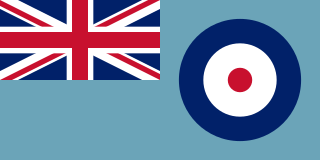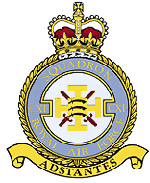
The Desert Air Force (DAF), also known chronologically as Air Headquarters Western Desert, Air Headquarters Libya, the Western Desert Air Force, and the First Tactical Air Force (1TAF), was an Allied tactical air force created from No. 204 Group RAF under RAF Middle East Command in North Africa in 1941 to provide close air support to the British Eighth Army against Axis forces. Throughout the Second World War, the DAF was made up of squadrons from the Royal Air Force (RAF), the South African Air Force (SAAF), the Royal Australian Air Force (RAAF), the United States Army Air Forces (USAAF) and other Allied air forces.
No. 155 Squadron RAF is a former Royal Air Force squadron.

Number 17 Squadron, currently No. 17 Test and Evaluation Squadron (TES), is a squadron of the Royal Air Force. It was reformed on 12 April 2013 at Edwards Air Force Base, California, as the Operational Evaluation Unit (OEU) for the Lockheed Martin F-35B Lightning.
835 Naval Air Squadron was a former squadron of the Royal Navy's Fleet Air Arm originally formed in February 1942 as a torpedo bomber and reconnaissance unit flying Fairey Swordfish. In June 1943, six Sea Hurricanes were added to the squadron as a fighter flight. The composite unit exchanged the Hurricanes in September 1944 for Grumman Wildcats, serving on until 1 April 1945, when the squadron disbanded.

Number 111 (Fighter) Squadron, also known as No. CXI (F) Squadron and nicknamed Treble One, was a squadron of the Royal Air Force. It was formed in 1917 in the Middle East as No. 111 Squadron of the Royal Flying Corps during the reorganisation of the Egyptian Expeditionary Force after General Edmund Allenby took command during the Sinai and Palestine Campaign. The squadron remained in the Middle East after the end of the First World War until 1920 when it was renumbered as No. 14 Squadron.

No. 34 Squadron RAF was a squadron of the Royal Air Force. During the First World War it operated as a reconnaissance and bomber squadron and in the 1930s operated light bombers. It was re-equipped with fighter-bombers in the later half of the Second World War and in the post-war period was reformed four times; first as a photo-reconnaissance unit, then anti-aircraft co-operation, then as a jet fighter squadron through the 1950s. It was last active in the 1960s, as a Blackburn Beverley transport squadron.

No. 20 Squadron is the Royal Air Force's Operational Conversion Unit (OCU) for ground-based Tactical Air Command and Control, and Air Battle Management. It is part of the RAF's Air Surveillance and Control System (ASACS) and is based at RAF Boulmer. It was allocated the role on 1 June 2021.

No. 46 Squadron of the Royal Flying Corps and the Royal Air Force, formed in 1916, was disbanded and re-formed three times before its last disbandment in 1975. It served in both World War I and World War II.

No. 247 Squadron was formerly a squadron of the Royal Air Force. It was also known as No. 247 Squadron in recognition of the donations made by the British communities of the foreign concessions established on the Chinese coast. The financial gift to provide two fighter squadrons also included the badge in the form of a scroll with Chinese characters Cheu Feng meaning "fierce wind" or Hurricane, and the motto "Rise from the East". The squadron was heavily involved in air operations during the Second World War, and the defence of the United Kingdom during the early years of the Cold War.

Army Aviation Centre (AAC) Middle Wallop is a British Army airfield located near the Hampshire village of Middle Wallop, used for Army Air Corps training. The base hosts 2 (Training) Regiment AAC and 7 (Training) Regiment AAC under the umbrella of the Army Aviation Centre. 2 (Training) Regiment performs ground training; 7 (Training) Regiment trains aircrew on AAC aircraft after they complete basic training at RAF Shawbury.
No. 52 Squadron was a Royal Air Force squadron that saw service in both World War I and World War II.
No. 113 Squadron began service in 1917 with the Egyptian Expeditionary Force commanded by General Edmund Allenby. Initially, the squadron was a unit of the Royal Flying Corps, serving during the Sinai and Palestine Campaign and as a reconnaissance, army cooperation, bomber, fighter, transport and missile operation squadron during its existence.
No. 261 Squadron RAF was a squadron of the Royal Air Force during World War I and World War II. It was involved in the defence of Malta from August 1940 till May 1941 and the campaign in Burma.

No. 205 Squadron was a Royal Air Force unit formed on 1 April 1918. Prior to this it had existed as No. 5 Squadron of the Royal Naval Air Service (RNAS). In 1929, it became the first RAF squadron to be permanently based in Singapore, taking as its motto Pertama di Malaya. No. 205 Squadron operated during the Second World War and the Cold War before disbanding on 31 October 1971.
No. 212 Squadron RAF is an inactive squadron of the British Royal Air Force.
821 Naval Air Squadron was a Royal Navy Fleet Air Arm carrier based squadron formed on 3 April 1933 with the transferral and amalgamation of the Fairey III aircraft from 446 and half of 455 Flight Flights Royal Air Force to the newly formed Fleet Air Arm of the Royal Air Force. The squadron operated during the Second World War.

No. 79 Squadron was a squadron of the Royal Air Force.

No. 237 Squadron was a Royal Air Force aircraft squadron. During the Second World War the unit was formed from No. 1 Squadron Southern Rhodesian Air Force for operations in North Africa.

No. 352 Squadron RAF was a Yugoslav-manned fighter-bomber squadron of the Royal Air Force during the Second World War. The squadron was also known as First NOVJ Squadron.
No 81 Squadron was a squadron of the Royal Air Force. It flew Fighter aircraft during the Second World War, and reconnaissance aircraft in the Far East after the war and was disbanded in 1970.











